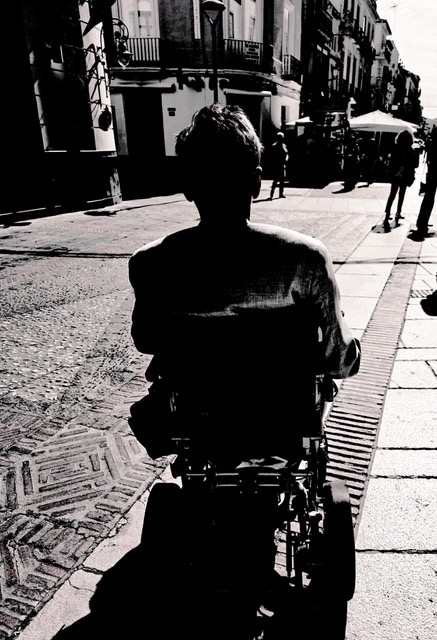
Geir. Photo © Karethe Linaae
Most people who move to Spain have their own requirements. According to real estate agents on the Costa del Sol, most people desire a south-facing terrace, ideally with mountain and sea views, proximity to downtown shops and restaurants, and, preferably, also within walking distance of the beach. But when you are in a wheelchair and dependent on extra oxygen, the requirements are completely different. Flat ground, wide sidewalks, and proximity to health facilities become essential.
New challenges
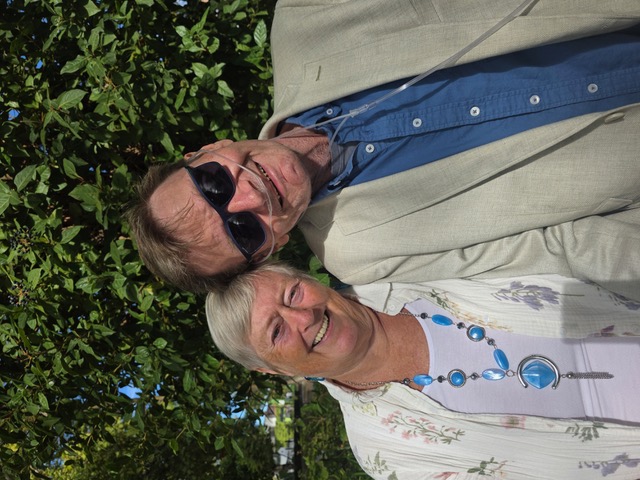
Geir and Anne-Grete, happy in Spain, October 2025. Photo © Karethe Linaae
She was a chef and head librarian from a fjord in Western Norway, and he was the secretary of the Transport Workers' Union. Both had been married before and had children of their own. However, in 2008, coincidences and an audio library for professional drivers on Highway E-3 brought Anne-Grete Bjørlo (69) and Geir Kvam (68) together. Eventually, their relationship became more than just audiobooks. Geir proposed in Italy in 2010, but before they had married, they got a ‘third wheel’ on the wagon – Geir's illness, severe, genetically determined emphysema.
Winters are tough in Norway, and even as both were still full-time employed, the couple began toying with the idea of moving south. The plans were put on hold during the pandemic, but in 2023, when they both retired, they took the plunge and decided to move to Spain.
All of us who have chosen to live in the South have our challenges. Life as a foreigner in a foreign country can bring its trials. Many experience communication problems, legal challenges, fear of being ripped off in real estate negotiations, or even a feeling of social isolation. In addition, recent years have brought new concerns with record temperatures and water shortages. My personal challenges when moving were learning the language, getting a Spanish driver’s license, buying a house and vehicle while trying to integrate into the local community, and making Spanish friends. It wasn’t always easy, but everything is relative.
Geir and Anne-Grete’s move brought a completely different set of challenges than most foreigners experience. Geir is in a wheelchair and depends on a regular oxygen supply, while Anne-Grete is his right hand in everything, every day. Many towns and villages in the Málaga Province were therefore out of the question for the couple. Picturesque alleys, beautiful cobblestone streets, buildings on steep slopes, winding sidewalks along flower-adorned walls that suddenly end in a high curb or steps, and pedestrian crossings without lights or ramps may not be a problem for most people who move down here. But what about when you can't walk on your own and have only 20% of your lung capacity?
A happy coincidence
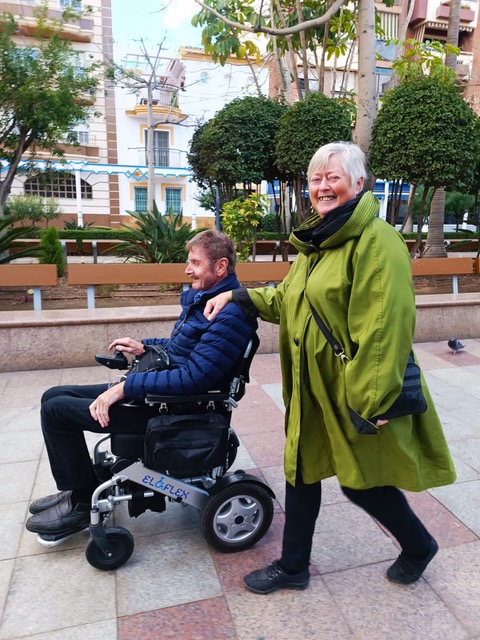
Anne-Grete and Geir on the beach promenade in Torre del Mar. Photo © Karethe Linaae
Finding what was to be their Spanish hometown happened by coincidence. Geir was training his legs on the treadmill at home in Oslo when the TV was showing a documentary about the Costa del Sol. First up was the town of Nerja, a lovely coastal city that they had visited, but which wasn’t very wheelchair friendly. The next part of the series was about a town they didn’t know - Torre del Mar in the municipality of Vélez-Málaga, also on the eastern Costa del Sol.
- Seeing the downtown area in the video, I thought, «Wow, that’s flat. I could live there!" The city appeared, for the most part, to have wide sidewalks and a pedestrian street that led down to the beach promenade. The entire centre seemed very accessible, which would mean that I could get out every day. If we were to remain in Oslo, I might have got out a couple of times each winter, Geir explains.
Anne-Gretes first reaction was that Torre del Mar was “just a bunch of boring low-rise buildings”, but when they explored it on Google Maps, she understood Geir’s point. They started circling areas on the map that had everything they needed within ‘wheeling’ distance. When they later searched for rental properties online, an apartment popped up. It was large, and the location was perfect. Using Google Translate and WhatsApp, they got in touch with the agent, who reserved the apartment.
- I flew down and brought Geir with me via video, and he just said, 'Go for it!' The next day, I signed a long-term rental contract, and now we have the world's loveliest Spanish family as landlords, exclaims Anne-Grete.
- Everything we need is within reach. The nearest hospital is right up the hill, I can roll to the medical centre in two minutes and do the shopping on my way home, adds Geir.
While many of the holiday apartments in the town are only intended for summer use, their flat is usable for year-round living. Yet, they noted significant differences between the building codes in Scandinavia and Spain. Sound insulation, for instance, can be rather poor, but that is part of life here.
- The electricity was a challenge, especially for me, who loves to cook. When I used the oven, I couldn’t use the hotplates at the same time, recalls Anne-Grete.
But she moved the old gas stove out onto the veranda and arranged an outdoor kitchen there, which now doubles as an extended living room in the summer. Later, the owners upgraded the electricity, so their time of frequent blackouts is over.
Immigration and bureaucracy

At home during the first winter. Photo © Karethe Linaae
Anne-Grete and Geir agree that the move was a big job. It was necessary to deal with the health and tax authorities in Norway, while a similar process awaited them in Spain.
- I tried to arrange a lot before Geir came down, but it took time to get NIE, a Spanish bank account and a mobile phone, which are absolutely necessary," warns Anne-Grete.
Residencia and Seguridad Social papers also came into place, and they had an accountant help with the Spanish tax return.
- In Norway, we were told that we’d have to pay tax there for the first three years, which turned out to be wrong. For 2024, our pensions were first taxed in Norway and later in Spain. Residents must pay tax in the country where they live, so proving Spanish residency became another hurdle in an already time-consuming process. Now that it’s finally sorted, next year will be easier! Just ensure that your electric bill is in your name — it’s proof of residency for the tax authorities, according to Anne-Grete.
Other things went more smoothly. When they brought their car from Norway, some new Spanish friends helped them rent handicap parking nearby for half the price they would have paid in Oslo.
The Spanish healthcare system, however, was more cumbersome than what they were used to back home. Blood test results that used to arrive within minutes in Oslo took a couple of weeks the first time, but with the help of their Spanish interpreter, they managed to streamline the process.
- You cannot fight the system, so you must figure out how to work best with it, says Geir, who is intimately acquainted with doctors.
Through the Spanish social security system, they now have free GP services and specialist services (pulmonologist in Geir’s case) and access to subsidised medication.
- It is vital to have a professional interpreter with you who knows the healthcare system if you have health challenges, not just a random person who knows a little Spanish, Geir points out.
An ordinary town for ordinary people
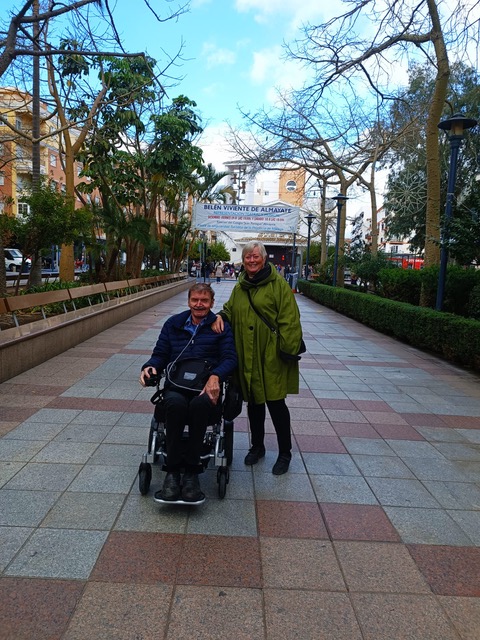
In Torre del Mar. Photo © Karethe Linaae
The Norwegian couple calls Torre del Mar “an ordinary town for ordinary people.” Their neighbourhood mostly consists of local Spaniards, both retirees and ordinary workers, while the city’s holiday apartments are mostly closer to the beach.
- The neighbours are very nice, says Anne-Grete. They open the front door for us and ask how Geir is if they haven’t seen him for a while. On our first Christmas Eve, the electricity went out, and the automatic fuse didn’t respond. The neighbours came over and helped us fix the problem. If there is anything, they’ll help.
Geir adds that people will even move chairs so that he can enter a restaurant or a café with his wheelchair.
- There's a lot more warmth in the way they do things. And they don't help because they have to, but just because that's how they are.
They have both found their daily routines in Torre del Mar. In the morning, Anne-Grete goes to the allotment garden she leases, a 20-minute stroll away.
- I also do the cooking. For me, cooking and buying ingredients is half the charm of living here. We have also built up a social circle with both Spanish and international friends. The conversation is a mixture of English and Spanish, with a little help from Google.
As for Geir, he often has periods with less than 20% of his normal lung capacity, so it takes a couple of hours to get his body going.
- I try to get out every day, although it must be planned. Otherwise, I write a little and play music on my own, and, if possible, I take my Fender to a jam session at a café down the street one evening a week.
Both started taking Spanish classes, but with all the paperwork and Geir’s health issues, they have put them on hold for now.
- The goal for me is to be able to master everyday conversations and be able to read books in Spanish, declares Anne-Grete, who learns a lot from the other hortelanos at the allotment garden, where she is the only foreigner.
- Grammar is the big problem. Now I understand why many foreigners in Norway struggle with grammar. It's not easy!
Geir often refers to Google and notices that when they try speaking in their stumbling Spanish, the locals seem happy that they are trying.
- That's really the best thing about our town – it is a very inclusive and still mainly Spanish coastal town.
No regrets
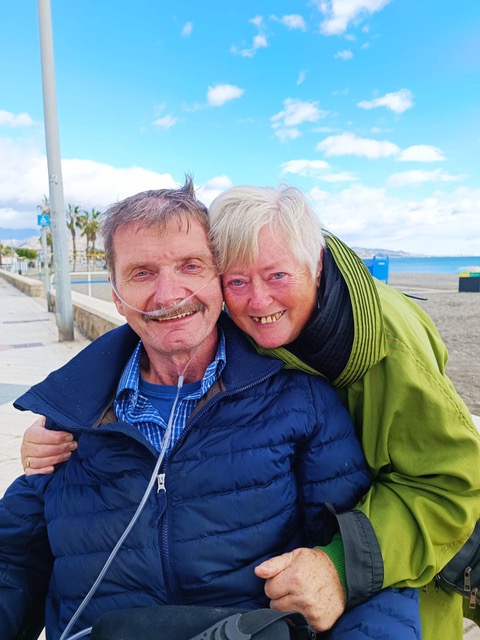
On the beach promenade during their first year in Torre del Mar. Photo © Karethe Linaae
Neither Anne-Grete nor Geir regret their decision to move for a second, and they are more than willing to share advice with others who plan to do the same:
- It’s never too late to make new choices — just think about what kind of life you want moving forward. If you can, start with a six-month stay, especially during the winter, when you get the most bang for your buck down here. And finally, use a broker and arrange everything in advance, is Anne-Grete’s advice.
- If we are going to live in Spain, it is our duty to adopt and learn how things are done here. What we think about the system is irrelevant, says Geir, who dealt with many bureaucrats in his former position.
- We cannot expect the Spanish health care, banks or road services to be the way we are used to. Be polite. Bureaucrats have a certain status here, but if one meets them with humility and a bit of humour, things will move ahead. After our third visit, we were already on greeting terms with the funcionarios in the town hall."
The freedom of public transportation
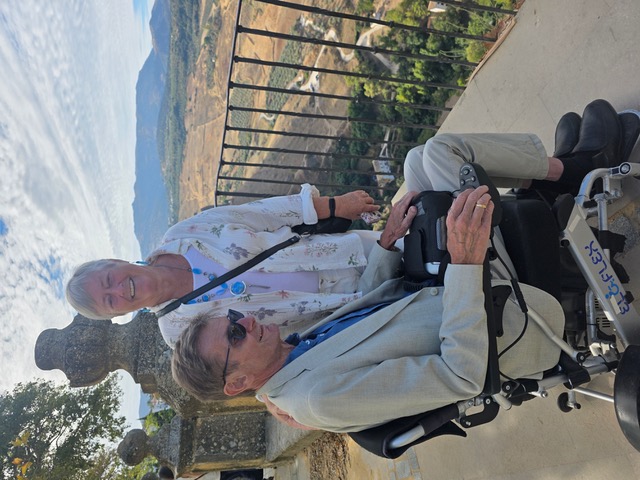
On a trip to Ronda. Photo © Karethe Linaae
This fall, Geir agreed to sell their car. It was a tough, but necessary, decision for the former truck driver. At the same time, they have begun to travel again, taking the train to Madrid (to renew a passport) and the bus to Ronda. They cannot be more pleased with the help and assistance they got wherever they went.
With Geir’s condition, they will always need a hand, as it is not only about mobility but also about oxygen. Geir sometimes has as low as 17% of his normal breathing capacity.
- If you completely tape your mouth and one nostril shut and then take the thinnest straw you can find and tape it to the other nostril, then you are where I am, he explains.
His reality certainly knocks out all my so-called challenges and will make me think twice before the next time I sulk about some public road works that never get finished or a neighbour who is a little too fond of late-night Flamenco serenades.
After almost two years on the Costa del Sol, they still agree that they found their dream location in Torre del Mar. Although life can be challenging, neither of them regrets moving to Spain – not for a second!
It is both inspiring and humbling to spend time with Anne-Grete and Geir and observe them in their everyday life. They have found a perfect ‘nest’ within rolling distance to everything they need and a neighbourhood that hardly has any foreigners. Geir’s life is a constant battle with lung infections and ‘refills’ of blood plaques. I cannot help but admire their positive, yet realistic, attitude.
- It was never our goal to climb Mount Everest, so we preferred to go to Spain. We focus on what we can do instead of what we can't, and this has given us many great experiences.

Strolling and rolling along. Photo © Karethe Linaae